Work Choice: referrals, starts and job outcomes to October 2019
Published 3 September 2020
Applies to England, Scotland and Wales
This is the final Work Choice statistical publication. There will be no further releases.
1. Main Stories
The key points from this release covering the final Work Choice statistics are:
- over the lifetime of the programme, there were 210,330 referrals and 158,420 starts to Work Choice
- of those starts, 55,330 (35%) achieved a short job outcome and 36,170 (23%) achieved a sustained job outcome
- for the final year of starts, over three quarters were claiming Jobseeker’s Allowance (JSA) or Universal Credit (UC) when they started
2. What was Work Choice?
Work Choice was a voluntary programme that helped disabled people find, keep and progress in a job. Referrals started in October 2010 and participants of WORKSTEP, Work Preparation, and the Job Introduction Scheme transitioned to Work Choice in November and December 2010.
Work Choice has now ended. Referrals ended in Scotland in April 2017, but continued in England and Wales up to February 2018, with the final job outcomes being claimed from programme providers in October 2019. Work Choice was followed by the Work and Health Programme in England and Wales.
Work Choice helped disabled people whose needs could not be met through other work programmes, Access to Work or workplace adjustments. This might be because they needed more specialised support to find employment or keep a job once they had started work.
Work Choice was delivered by providers funded by the government. The type of help participants got depended on what they needed. It was different for everyone but could include: training and developing participants’ skills; building confidence; interview coaching; and helping employers to employ disabled people.
The Work Choice delivery model changed for new participants from April 2017. Two levels of support were available to participants after this point:
-
Work Entry Support – advice on work and personal skills to help participants find a job. This was normally expected to last 6 months, but could have been extended by 3 or 6 months in exceptional circumstances and when there was a clear prospect of a job
-
In-Work Support – help to start work and stay in a job. In-Work Support was normally expected to last for up to 12 months, but could have lasted for up to 2 years
Read the background information note (section 2) for further information.
3. What do these statistics show?
This is the official statistical publication on Work Choice. It contains the final figures on referrals, starts, and job outcomes for all Work Choice providers, from October 2010 up to and including October 2019. Job outcomes include:
- supported or unsupported jobs which last, unbroken, for at least 13 weeks: short job outcomes
- movements from supported to unsupported work: unsupported job progressions
- unsupported jobs sustained for at least 26 weeks out of a 30-week period: sustained, unsupported job outcomes
In April 2015, Remploy was awarded a Work Choice contract in addition to pre-existing providers. Remploy data are included in most tables from April 2015 onwards. However, to allow comparisons over time, some tables exclude Remploy data.
Some tables and charts compare job outcome rates by cohorts based on the month in which they started Work Choice. To allow a consistent comparison over time, a cut-off of 12 or 24 months has been applied to short job outcomes and job progressions and sustained job outcomes respectively for the cohort analysis.
In England and Wales, new referrals ended in February 2018 and new starts ended between March and April 2018. The final date for which a sustained job outcome could be claimed in England and Wales was October 2019. This means participants who started between November 2017 and April 2018 had fewer than 24 months to achieve a sustained job outcome, and therefore are not fully comparable to earlier cohorts.
The definition of short job outcomes changed with the introduction of the extended contract for those people referred on or after 25 October 2015. This has impacted on the numbers that achieved a short job outcome within 12 months and introduced a discontinuity to the short job outcome time series.
Read the background information note (section 4.3) for more details.
Figure 1: Participant Journey on the Work Choice programme
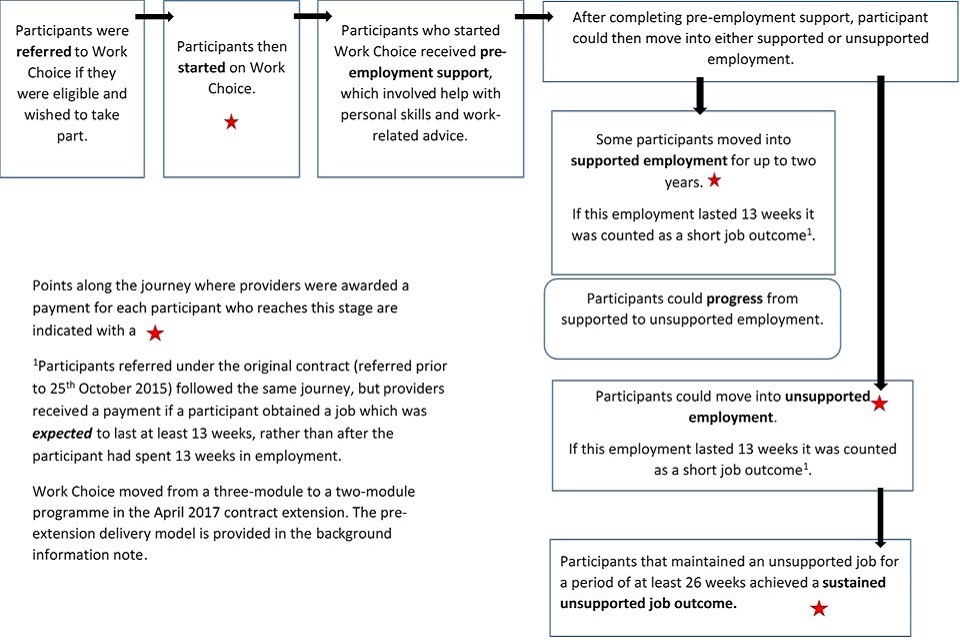
4. Referrals and Starts
81% of those referred to Work Choice subsequently started on the programme.
Figure 2: The number of referrals and starts to Work Choice each month

The key points from this figure are:
- over the whole programme, there were 210,330 referrals and 158,420 starts to Work Choice
- in the final year in which referrals were being made, between March 2017 and February 2018, there were 34,320 referrals and 25,090 starts
- Referrals and Starts from April 2017 are not comparable with previous periods since referrals were no longer made in Scotland from this point
For full data, see Table 1 of the data tables accompanying this release.
5. Short Job Outcomes
The majority of short job outcomes achieved were supported rather than unsupported.
Figure 3: Proportion of starts that achieved a supported or unsupported short job outcome within 12 months, by start month
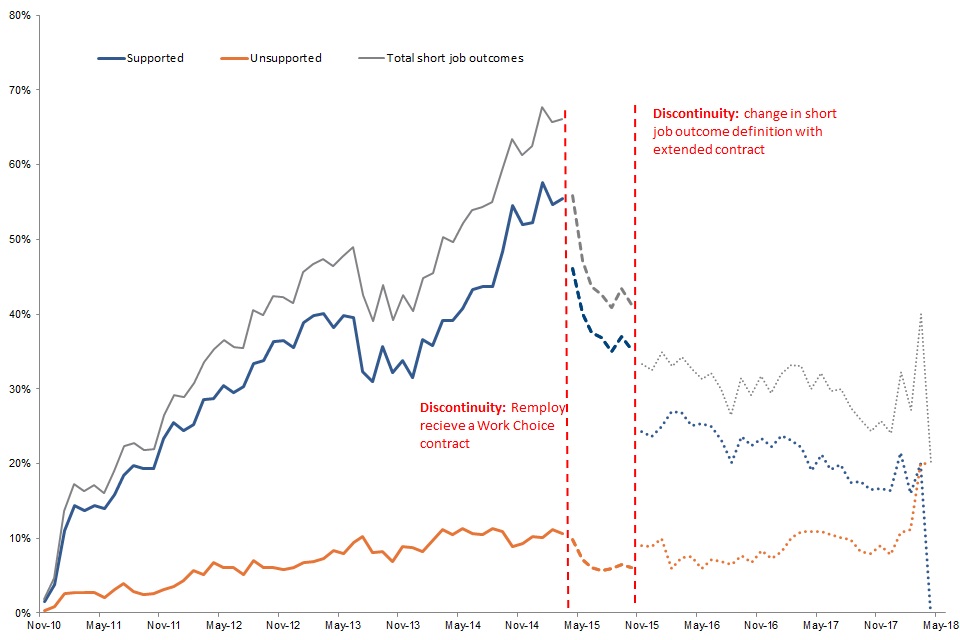
The key points from this figure are:
- of the 158,420 Work Choice starts over the whole programme, 55,330 (35%) achieved a short job outcome
- the proportion of starts that obtained a short job outcome increased from the start of the programme up to March 2015, when there is a discontinuity in the series due to Remploy receiving a Work Choice contract
- of those who started between the contract extension in October 2015 and the end of the programme, 30% achieved a short job outcome within 12 months of starting
- participants were more likely to obtain a supported short job outcome than an unsupported one. Of those who started between October 2015 and the end of the programme and who achieved a short job outcome, 72% of the short job outcomes were supported and 28% were unsupported
- figures for March and April 2018 should be interpreted with caution as they are based on a small number of starts
For full data, see Table 2 of the data tables accompanying this release.
6. Sustained Job Outcomes
The proportion of Work Choice starts who achieved a sustained job outcome changed over time.
Figure 4: Proportion of starts that achieved a sustained job outcome within 24 months, by start month

The key points from this figure are:
- of the 158,420 Work Choice starts over the whole programme, 36,170 (23%) achieved a sustained job outcome
- the proportion of Work Choice starts achieving a sustained job outcome within 24 months saw a steady rise from the start of the programme to March 2015 (when Remploy received a Work Choice contract)
- This decreased slightly towards the end of the programme, from 25% in February 2017 to 16% in October 2017 (the last month for which starts had 24 months to obtain a sustained job outcome)
- participants who started between November 2017 and April 2018 had fewer than 24 months to achieve a sustained job outcome, and therefore are not fully comparable to earlier cohorts
- figures for March and April 2018 should be interpreted with caution as they are based on a small number of starts
For full data, see Table 2 of the data tables accompanying this release.
7. Benefit claimed at the point of referral
More than half of people who volunteered for Work Choice in the final year were claiming JSA or UC.
Figure 5: Proportion of starts by benefit claimed at referral, for starts between April 2017 and March 2018

The key points from this figure are:
- 51% of people who started Work Choice in the final year were claiming JSA (with or without also claiming DLA and PIP) with a further 26% claiming UC
- 5% were claiming no benefit on referral
For full data, see Table 4 of the data tables accompanying this release.
Job outcome rates vary by participant benefit type.
Figure 6: Proportion of starts that achieved a job outcome by benefit claimed at referral, for starts between April 2017 and March 2018
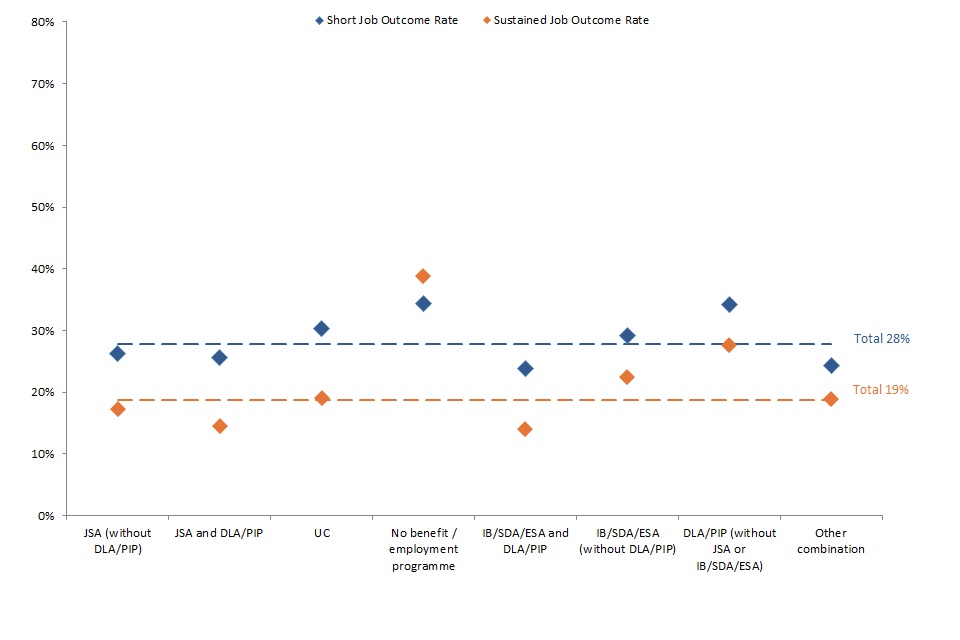
The key points from this figure are:
-
based on the final year of starts, and excluding the ‘No benefit/ employment programme’ group, the proportion of Work Choice starts that achieved a job outcome varies by benefit type between:
- 24% and 34% for short job outcomes (within 12 months)
- 14% and 28% for sustained job outcomes (within 24 months)
For participants who were on no benefit or employment programme on referral, more are recorded as having achieved a sustained job outcome than a short job outcome. This could be due to 3 reasons:
-
A short job outcome was achieved outside of the 12-month cut-off but a sustained job outcome was achieved within 24 months
-
The participant had breaks in their employment (short job outcomes required 13 weeks of unbroken employment, whereas sustained job outcomes required 26 out of 30 weeks of employment).
-
Many of this group are ‘Retention’ participants, who were in work but at risk of falling out of work when starting on Work Choice. For Retention participants, providers could not claim short job outcomes as the participant was already in work, but they could claim sustained job outcomes if the employment was sustained for 26 weeks out of 30 after the support was withdrawn
For full data, see Table 4 of the data tables accompanying this release.
8. Primary Disability type
Mild to moderate mental health condition was the most prevalent primary disability of those starting on Work Choice in the final year.
Figure 7: Proportion of starts by primary self-reported disability type, for starts between April 2017 and March 2018
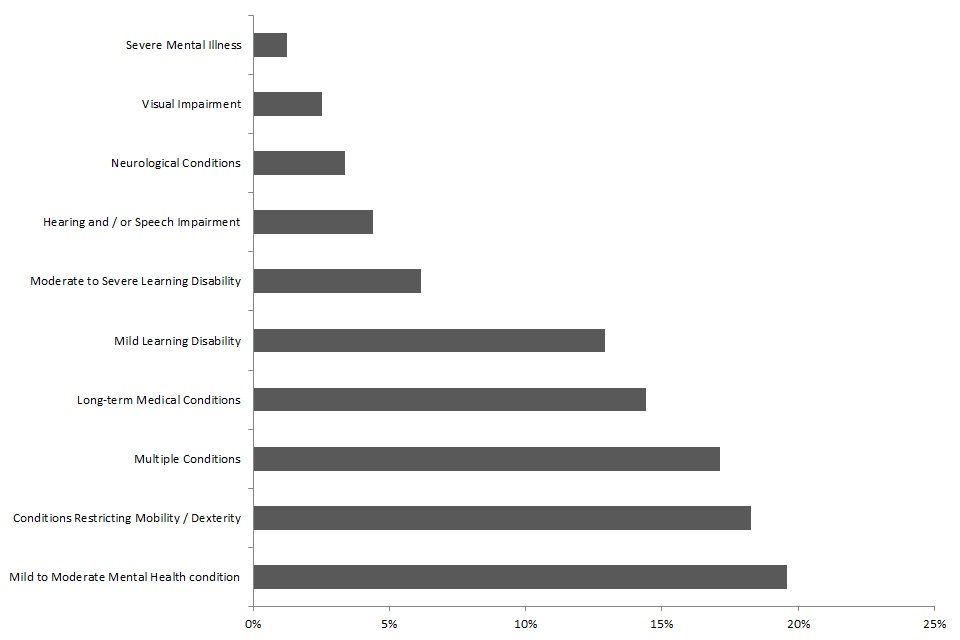
The key points from this figure are:
- proportions are calculated as a percentage of total starts excluding those in the ‘missing’ disability category
- the most prevalent self-reported primary disabilities of those who started Work Choice in the final year were mild to moderate mental health conditions and conditions restricting mobility and dexterity, with these disability types accounting for 17% and 16% respectively
For full data, see Table 3 of the data tables accompanying this release.
Variation in job outcome rate by primary disability type.
Figure 8: Proportion of starts that achieved a job outcome by primary self-reported disability type, for starts between April 2017 and March 2018
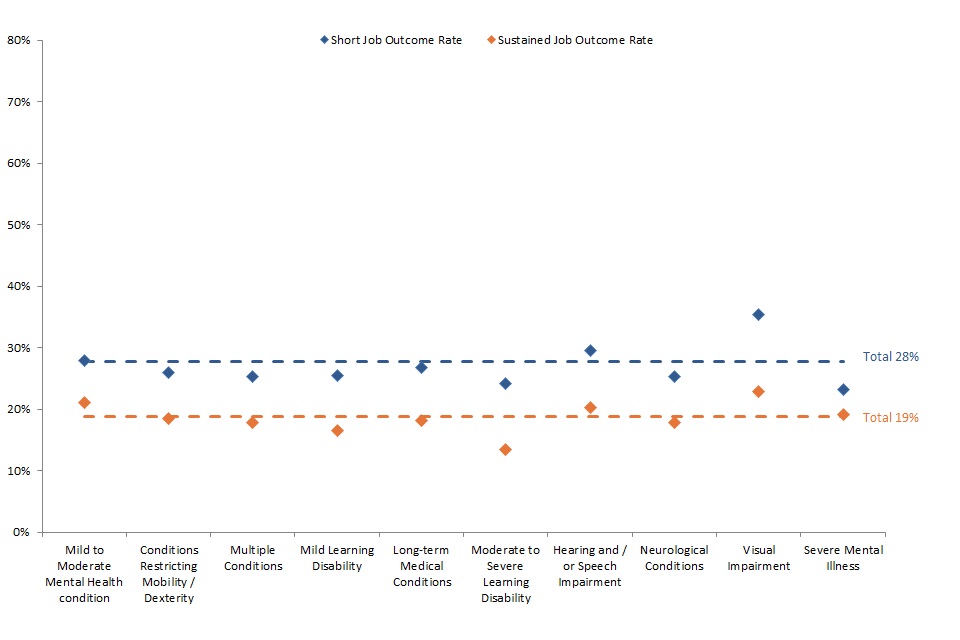
The key points from Figure 8 are:
- based on the final year of starts, the proportion of Work Choice starts that achieved a job outcome varies by primary self-reported disability type between:
- 23% and 35% for short job outcomes (within 12 months)
- 13% and 23% for sustained job outcomes (within 24 months)
For full data, see Table 3 of the data tables accompanying this release.
9. More information
Data for these statistics are derived from the Labour Market System (LMS) Opportunity Type database, the Provider Referrals and Payments System (PRaP), and the DWP National Benefit Database (NBD).
Some data within this publication may include revisions to previous releases. For more information on revisions read the background information note.
Note that the methodology used to obtain the benefit claimed on referral (as in figures 5 and 6 and tables 4 and 4b) has been improved since the previous statistical release in August 2018. This has caused a small change in figures, including a reduction in the proportion of starts in the ‘No benefit’ group from 9% in the previous release to 5% in this release. See the background information note (section 4.3.4 ) for more information.
10. Where to find out more
See the Work Choice background information note for more information about Work Choice and these statistics,
Read more information about the different benefits that participants on Work Choice may have claimed.
Read the 2013 Work Choice qualitative evaluation.
Collection of Work and Health Programme statistics.
Collection of the Specialist Employability Support Statistics.
11. Contact details
For queries or feedback on this publication, please contact: team.workandhealthanalysis@dwp.gov.uk
For press queries, please contact: 0203 267 5129
ISBN number: 978-1-78659-271-2
